Let’s face it, rarely do we see a headline that says, “Rainforest is Doing Great” or “The Coral is Much Better Now.” Sometimes it feels like there isn’t much we can do as individuals to change things, but the truth is that making an impact (good OR bad) isn’t nearly as hard (or as obvious) as you may think. Sustainable tourism, including eco-tourism, is only possible with the active support of tourists and tour operators alike. Travelers can choose to have a positive impact on their holiday destination. We’ve provided some information below to highlight some key areas related to sustainable tourism on Grand Turk.
The gorgeous waters which surround Grand Turk are irreplaceable and protecting this environment has become more and more challenging in light of the increase in the number of visitors our island has seen in recent years. We have a National Marine Park established for protection of designated areas, as well as guidelines for the protection of marine life. If each person visiting Grand Turk were familiar with these guidelines and followed them, as well as actively practicing responsible snorkeling and diving behaviors, it would go a long way to preserving the natural beauty we have been blessed with!
Our Environmental Responsibility page, combined with the additional best practices below, provides information relevant to the preservation of our precious marine environment and help contribute to sustainable eco-tourism. Much of this information is also applicable to ANY location where tourists and marine life are in close proximity. The Responsible Snorkeling and Diving practices tips come in handy when snorkeling and diving in any marine environment. Remember, when humans are in the ocean, we are only visitors (and uninvited ones, at that)!
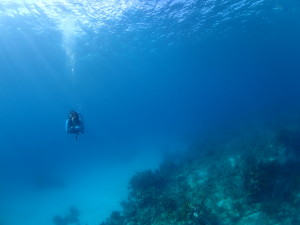 A few simple, environmentally responsible techniques can help scuba divers and snorkelers protect fragile coral reefs and other underwater ecosystems. Using the guidelines below should enhance the diving/snorkeling experience for you as well as the reef, and help preserve both for generations to come.
A few simple, environmentally responsible techniques can help scuba divers and snorkelers protect fragile coral reefs and other underwater ecosystems. Using the guidelines below should enhance the diving/snorkeling experience for you as well as the reef, and help preserve both for generations to come.
1. Simply relax and move slowly.
Marine life is less threatened by a relaxed diver/snorkeler. Swimming slowly is not only more comfortable for you, but also is less likely to intimidate the wildlife we have all come to observe. Many creatures are extremely sensitive to vibrations in the water, and in fact depend on this sense for their survival. Quick motions of snorkelers are easily perceived as potential threats by many fish and invertebrates.
No matter how strong you are, humans simply cannot out swim animals such as whales, rays, turtles, fish and squid. Although the impulse may be to pursue these animals for a closer look, this will only scare them away. The relaxed diver/snorkeler will find that aquatic mammals (including your buddy), fish, and invertebrates will continue their natural behavior, while allowing you to approach them much more intimately.
2. Minimize contact with the reef.
Learning to control our movements and position in the water benefits our own comfort and safety as well as the health of the reef. Both are important! The Leave-No-Trace motto of “take only photos, leave only foot prints” doesn’t quite apply to scuba divers and snorkelers, who don’t leave footprints. However, scuba divers and snorkelers sometimes leave fin-marks. For example, beginning divers may inadvertently kick a coral reef and destroy an entire community of living organisms. Or a snorkeler may carelessly stand on living coral and severely damage it, possibly permanently.
One of the world’s most complex ecosystems, coral reefs are vulnerable to diver and snorkeler impact. Reefs are constructed primarily by colonies of coral animals called polyps. By secreting a limestone skeleton, covered with a thin veneer of living tissue, over many years these slow growing creatures essentially create their own geology. Although the limestone is durable, the soft-bodied polyps can easily be damaged by contact with hands, fins, etc. Hands, fins, etc. can also cut through the coral’s protective outer tissue, letting in bacteria and micro-organisms that can kill it. While the loss of one polyp or a cut in the outer tissue doesn’t appear to be such a big problem, this spot will be more susceptible to infections and can cause additional death(s) in the colony.
Besides the impact on the coral, accidentally bumping into the reef can also harm you. Coral will easily cut through your soft skin, especially after you have spent some time in the water. Cuts in general, and coral cuts in particular, will heal slowly in the tropics, and are more susceptible to infection.
Be aware. Diving and snorkeling take place three dimensionally. Divers move not only forward and backward, and side-to-side, but up and down, as well. Paying attention to what is behind (watching feet and fins), and remember that metal tanks and fins can cause severe damage when banged against coral. For the mutual benefit of the reef and ourselves, we believe it’s both prudent and responsible to master the skills needed to minimize accidental close encounters with coral.
3. Live and let live.
In contrast to its initial appearance of grandeur, living space on the reef is very scarce. Every little niche is or will be occupied soon by an organism of some type. Empty shells are a valuable part of the ecosystem, and they get recycled many times. Besides the obvious environmental concerns, some “live shells” can be quite dangerous. Some of the most beautiful (cone shells for example) contain animals that are highly toxic and when “captured” can cause serious problems. Shell collecting is illegal in the Marine Park, other than items found above the high tide line.
4. Leave nothing but bubbles.
Although you don’t see as many signs as along a typical highway, littering under water is just as inappropriate as it is on land. We always carry trash containers on our boats. Please use these containers rather than disposing refuse in the water. Pick up any trash you may come across and bring it back to the surface. Pay special attention to plastic bags. They blow away easily, and once in the water they closely resemble jellyfish, the main diet of many turtles.
5. Avoid fish feeding and marine life harassment.
While dispersing “food” in the water seems an easy way to attract large numbers of fish, it will often attract just certain species that usually chase other species away. Clearly, this alters the natural behavior (and diet) of fish we have come to observe. This can also cause a negative ripple effect on the health of the marine ecosystem. Observing marine life in the wild can be done responsibly without causing disturbance or injury. Therefore, we do not allow fish feeding or marine life harassment on our trips. Express concerns to dive operations that feed, put out chum, and/or harass marine life…or better yet, ask that it not be done. For more information, check out this site.
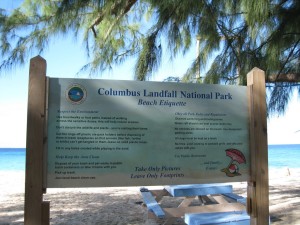 On the west side (leeward) of Grand Turk, approximately 2012 acres have been designated as the Columbus Landfall National Marine Park, a protected marine area. This marine park includes a dive mooring buoy system which was established in the 1980’s (with the assistance of Blue Water Divers!) in order to help reduce damage from boat anchors to the reef in the marine park. The protected area goes up to the hide tide mark, and includes anything found there. You can help by respecting the boundaries of the National Marine Park and not taking anything from within it (including shells), and also by educating others about the importance of protected areas such as the Marine Park.
On the west side (leeward) of Grand Turk, approximately 2012 acres have been designated as the Columbus Landfall National Marine Park, a protected marine area. This marine park includes a dive mooring buoy system which was established in the 1980’s (with the assistance of Blue Water Divers!) in order to help reduce damage from boat anchors to the reef in the marine park. The protected area goes up to the hide tide mark, and includes anything found there. You can help by respecting the boundaries of the National Marine Park and not taking anything from within it (including shells), and also by educating others about the importance of protected areas such as the Marine Park.
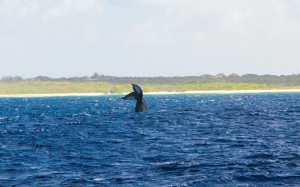 Although Blue Water Divers does not conduct whale watching tours, we understand that some of our customers wish to participate in such activities, and we strongly support DEMA’s new voluntary whale watching guidelines. Organizations may volunteer to agree to these guidelines, and we encourage our customers to only participate with whale watching companies that do so.
Although Blue Water Divers does not conduct whale watching tours, we understand that some of our customers wish to participate in such activities, and we strongly support DEMA’s new voluntary whale watching guidelines. Organizations may volunteer to agree to these guidelines, and we encourage our customers to only participate with whale watching companies that do so.
Below is a copy of the DEMA (Department of Environment and Maritime Affairs) whale watching guidelines and their intent:
“A population of humpback whales migrates from the cold waters of Iceland and Southern Greenland to the Silver Banks and potentially the Turks Bank, where they mate and give birth each winter. During this period and after giving birth, the whales travel around on the Turks, Caicos and Muchoir Banks. The presence of aggregations of humpback whales close to the Turks and Caicos Islands has given rise to opportunities for whale watching.
The advantages of whale watching are wide: it provides an opportunity to teach people to appreciate and understand the value of whales and other cetaceans; it fosters research; it contributes to the conservation of the animals; and helps ensure the economic security of local communities which serve as protectors of marine habitat. It is estimated that from December to April, during the whale migration, Salt Cay and Grand Turk receive 75% of their tourists and operators earn up 70% of their annual income. If conducted appropriately and ethically, whale watching excursions can provide sustainable livelihoods for water sports small business owners throughout the Turks and Caicos Islands.
The Grand Turk Cruise Centre (GTCC) is projected to facilitate one-million visitor arrivals in 2014. With increased tourism pressures on whale populations, guidelines governing human/whale interaction are critical in order to protect both human and whale interests.
In view of the above, by signing below, I agree to comply with the following voluntary code of ethics for whale watching:
If you are interested in whale watching, please review and familiarize yourself with these ethics.
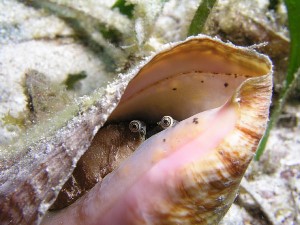 Conch are a local delicacy and have a long history here on the island. There was a time when there were enough conch around Grand Turk that they were a main source of sustenance for the people living here. Unfortunately, conch are now much more rare. As a result, they are protected internationally by the Convention on International Trade in Endangered Species of Wild Fauna and Flora (CITES) rules. If you find a living conch PLEASE do not disturb it, and keep in mind it is illegal to take ANYTHING (even a shell with “nobody home”) from the Columbus Landfall National Park, which encompasses the entire west side of Grand Turk up to the high tide mark. If you are interested in buying a conch shell from a local vendor who gathered their shells OUTside of the park, you should be aware of the international CITES rules and you can find them here.
Conch are a local delicacy and have a long history here on the island. There was a time when there were enough conch around Grand Turk that they were a main source of sustenance for the people living here. Unfortunately, conch are now much more rare. As a result, they are protected internationally by the Convention on International Trade in Endangered Species of Wild Fauna and Flora (CITES) rules. If you find a living conch PLEASE do not disturb it, and keep in mind it is illegal to take ANYTHING (even a shell with “nobody home”) from the Columbus Landfall National Park, which encompasses the entire west side of Grand Turk up to the high tide mark. If you are interested in buying a conch shell from a local vendor who gathered their shells OUTside of the park, you should be aware of the international CITES rules and you can find them here.
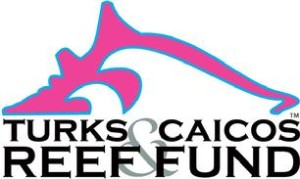 The Turks and Caicos Reef Fund (TC Reef Fund) is a non-profit organization which was formed in 2010 to benefit the marine environment in the Turks and Caicos Islands (TCI). The TC Reef Fund was established to help preserve and protect the marine environment of the “Beautiful by Nature” Turks and Caicos Islands – an environment that draws so many visitors to these islands and is critical to the survival of the islands themselves. Their goal is to dedicate 85+% of all funds raised through this organization to marine conservation projects in the TCI each year. You can read more about this NGO on their website.
The Turks and Caicos Reef Fund (TC Reef Fund) is a non-profit organization which was formed in 2010 to benefit the marine environment in the Turks and Caicos Islands (TCI). The TC Reef Fund was established to help preserve and protect the marine environment of the “Beautiful by Nature” Turks and Caicos Islands – an environment that draws so many visitors to these islands and is critical to the survival of the islands themselves. Their goal is to dedicate 85+% of all funds raised through this organization to marine conservation projects in the TCI each year. You can read more about this NGO on their website.
One fundraising mechanism implemented by the TC Reef Fund is to issue VOLUNTARY BC tags ($10) and wrist bands ($5) for the Marine Park. These are available to divers, snorkelers, fishermen, boaters, beachcombers and anyone else wishing to help in preserving our beautiful marine ecosystem. Dive operators working with the TC Reef Fund welcome the generosity of visiting park users and supporters to combine with their own marine conservation efforts. Come visit us, pick up a dive tag and/or wrist band, and lend your support to this important cause! Make a difference!